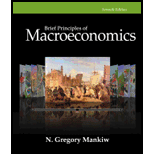
Time taken for the
Answer to Problem 1QCMC
Option ‘b’ is correct.
Explanation of Solution
Option (b):
Many studies suggest that it takes at least 6 months for the monetary policy to have an effect on aggregate demand. Monetary policy affects aggregate demand primarily by changing interest rates. However, mostly households and firms set their spending plans in advance; as a result, there is a time lag for changes in interest rate to alter the aggregate demand for goods and services Thus, option ‘b’ is correct.
Option (a):
Monetary policy works with a lag and hence, one month is insufficient for the monetary policy to reflect changes in the economy. Thus, option ‘a’ is incorrect.
Option (c):
Long lags suggest a policy that is passive rather than active, and such long gaps have an opposite effect on the economy (destabilization) as the economic conditions change from time to time. Two years is a long lag and thus, option ‘c’ is incorrect.
Option (d):
Long lags suggest a policy that is passive rather than active and such long gaps have an opposite effect on the economy (destabilization) as the economic conditions change from time to time. Five years is a really long lag and thus,option ‘d’ is incorrect.
Monetary policy: It refers to the credit
Want to see more full solutions like this?
Chapter 18 Solutions
Brief Principles of Macroeconomics (MindTap Course List)
- If a nation’s central bank, such as the US Federal reserve, believes the economy is headed toward a recession, what actions should it take?arrow_forwardWhat can be used to reduce aggregate demand and helps to control demand pull inflation?arrow_forwardb. How do fiscal and monetary policies differ in their approaches to managing the economy during periods of recession? Provide examples of each policy tool.arrow_forward
- classical economists a. argued that money supply determined aggregate demand b. believed that the quantity of money influences interest rates and real wages c. regarded monetary policy as unimportant since quantity of money does not determine price level. d. that prices would increase more than proportionate to an increase in money supplyarrow_forwardWhat causes the rate of inflation in macroeconomics?arrow_forwardWhat measures should the central bank take to reduce inflation? Show by drawing a graph.arrow_forward
- Opponents of using policy to stabilize the economy generally believe that a. neither fiscal nor monetary policy have much impact on aggregate demand. b. attempts to stabilize the economy can increase the magnitude of economic fluctuations. c. unemployment and inflation are not cause for much concern. d. All of the above are correct.arrow_forwardExplain in details how high inflation can lead to a recession in several ways.arrow_forwardHow does aggregate demand affect inflation? How do interest rates affect aggregate demand?arrow_forward
- When deciding whether to whether to tighten or loosen monetary policy, central banks weigh the relative risks to price stability and growth. Mention two indicators that the monetary policy control use to gauge the risk to inflation and two indicators the monetary policy control use to gauge the risk to growth.arrow_forwarda. Inflation in Theoretica is currently below the target range of its central bank. What does this tell you regarding Theoretica's likely output gap?arrow_forwardWhen fighting a recessionary gap, central banks will amount of loans being provided by commercial banks. Select one: a. Increase; decrease b. Decrease; increase the bank rate in order toarrow_forward
 Brief Principles of Macroeconomics (MindTap Cours...EconomicsISBN:9781337091985Author:N. Gregory MankiwPublisher:Cengage Learning
Brief Principles of Macroeconomics (MindTap Cours...EconomicsISBN:9781337091985Author:N. Gregory MankiwPublisher:Cengage Learning Economics (MindTap Course List)EconomicsISBN:9781337617383Author:Roger A. ArnoldPublisher:Cengage Learning
Economics (MindTap Course List)EconomicsISBN:9781337617383Author:Roger A. ArnoldPublisher:Cengage Learning
 Economics Today and Tomorrow, Student EditionEconomicsISBN:9780078747663Author:McGraw-HillPublisher:Glencoe/McGraw-Hill School Pub Co
Economics Today and Tomorrow, Student EditionEconomicsISBN:9780078747663Author:McGraw-HillPublisher:Glencoe/McGraw-Hill School Pub Co






